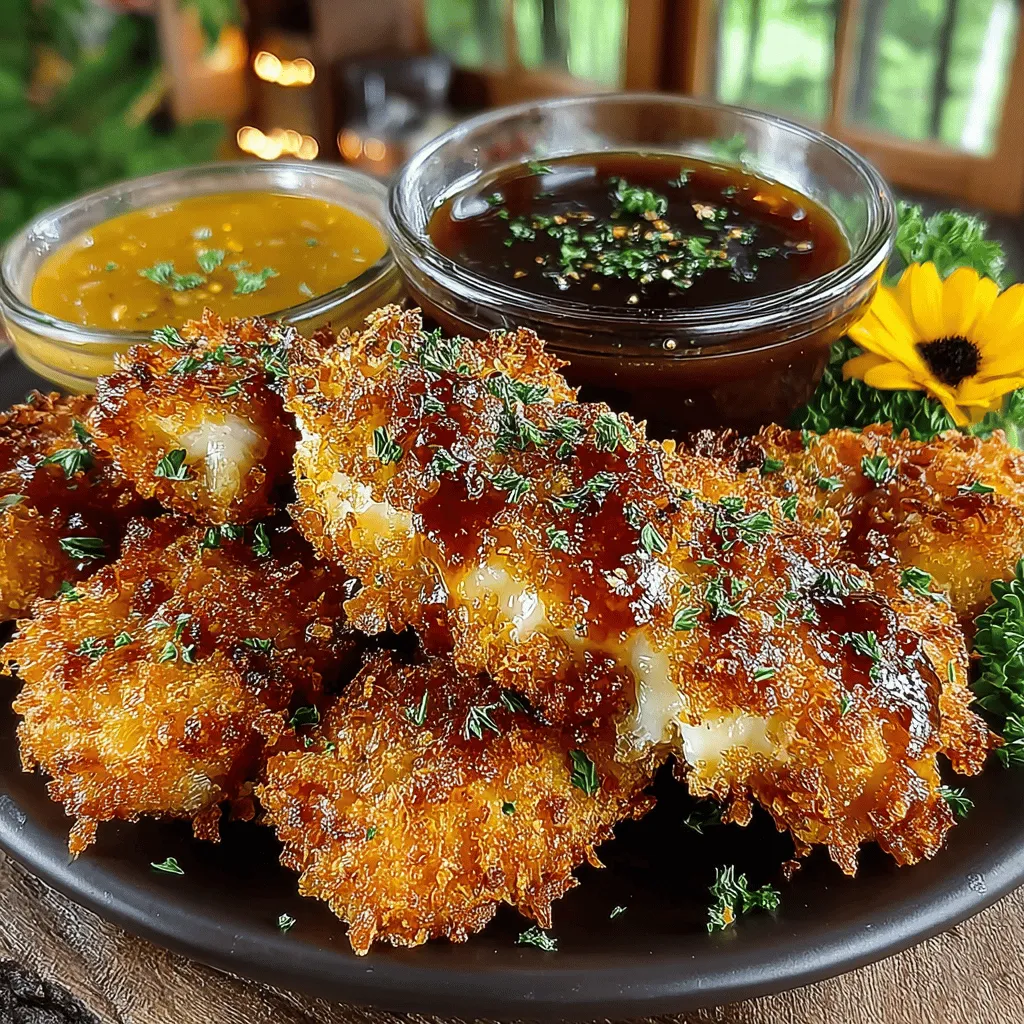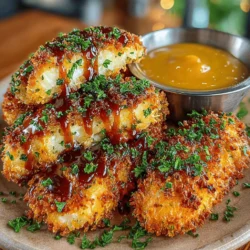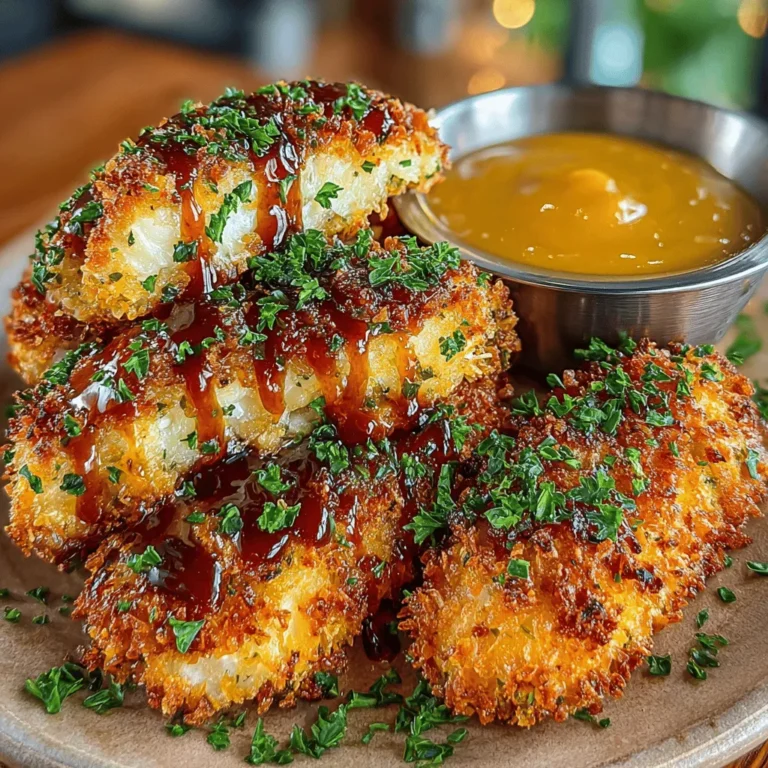Chicken tenders are a beloved dish in many households, cherished for their crispy texture and tender meat. This recipe takes the classic chicken tender and gives it a unique twist with a delightful sweet honey mustard dip that elevates the dish to a new level. Homemade chicken tenders not only offer a healthier alternative to store-bought options but also provide an opportunity to impress family and friends during casual meals or entertaining gatherings.
Ingredients
– 1 pound boneless, skinless chicken breasts
– 1 cup buttermilk
– 1 teaspoon paprika
– 1 teaspoon garlic powder
– 1 teaspoon onion powder
– ½ teaspoon salt
– ½ teaspoon black pepper
– 1 cup panko breadcrumbs
– ½ cup all-purpose flour
– Oil for frying
For the Sweet Honey Mustard Dip
– ½ cup mayonnaise
– 2 tablespoons honey
– 2 tablespoons Dijon mustard
– 1 teaspoon apple cider vinegar
Instructions
1. Prepare the Chicken: Cut the chicken breasts into strips of uniform size to ensure even cooking.
2. Marinate the Chicken: In a bowl, combine the chicken strips and buttermilk. Allow to marinate for at least 30 minutes in the refrigerator for optimal tenderness.
3. Mix Dry Ingredients: In a separate bowl, combine the paprika, garlic powder, onion powder, salt, and pepper. In another bowl, place the flour and in a third, the panko breadcrumbs.
4. Coat the Chicken: Remove the chicken from the buttermilk marinade, allowing excess to drip off. Dredge each strip first in the flour, then dip it back into the buttermilk, and finally coat it thoroughly with the panko breadcrumbs.
5. Heat the Oil: In a large skillet, heat oil over medium-high heat. The oil should be hot enough that a breadcrumb dropped into the oil sizzles immediately.
6. Fry the Chicken: Carefully add the coated chicken strips to the hot oil, cooking in batches if necessary to avoid overcrowding. Fry each side for about 3-4 minutes or until golden brown and cooked through.
7. Drain Excess Oil: Once cooked, transfer the chicken tenders to a paper towel-lined plate to drain excess oil.
Understanding the Ingredients
Chicken Breast
Using high-quality chicken breast is essential for achieving the best flavor and texture. Fresh, organic chicken tends to be more tender and juicy, making it ideal for this recipe.
Seasonings
The combination of paprika, garlic powder, onion powder, salt, and pepper serves to enhance the overall taste. Each seasoning contributes to a complex flavor profile that elevates the chicken tenders beyond basic fried chicken.
Buttermilk
Buttermilk plays a crucial role in this recipe by tenderizing the chicken. The acidity in buttermilk breaks down the proteins in chicken, resulting in a more succulent texture, while also adding a distinct flavor.
Breadcrumbs
Panko breadcrumbs are preferred for this recipe due to their larger size and airy structure, which creates an extra crunch when fried. They provide a delightful contrast to the tender chicken inside.
Sweet Honey Mustard Dip Ingredients
The sweet honey mustard dip complements the chicken tenders beautifully, adding a layer of flavor that balances the savory notes of the fried chicken.
Mayonnaise
Mayonnaise adds creaminess to the dip and helps to mellow the flavors of the mustard and honey, creating a harmonious blend.
Honey and Dijon Mustard
The combination of honey and Dijon mustard offers a perfect balance of sweetness and tanginess, enhancing the overall dip experience.
Apple Cider Vinegar
A splash of apple cider vinegar adds acidity, which brightens the flavors and cuts through the richness of the mayonnaise.
Step-by-Step Preparation of Chicken Tenders
Mixing the Dry Ingredients
It’s important to thoroughly mix the dry ingredients to ensure that each piece of chicken is seasoned evenly. This uniformity in flavor is key to delicious chicken tenders.
Coating Techniques
Proper coating techniques are essential for achieving maximum crunch. The three-step process of flour, buttermilk, and panko ensures that the breading adheres well to the chicken, creating a crispy exterior.
Visualizing the Process
Consider documenting your cooking journey by taking photos or videos. This not only makes for a fun experience but also allows you to share your culinary creation with others, showcasing the process and the delicious results.
Cooking the Chicken Tenders
The frying process is crucial for achieving that golden crunch on the chicken tenders. Monitoring the oil temperature and cooking time will ensure perfectly fried chicken that is crispy on the outside and juicy on the inside.

Importance of Proper Frying Techniques
Frying chicken tenders to perfection requires attention to detail, particularly when it comes to technique. Mastering the art of frying can elevate your dish from good to great, ensuring that your chicken is crispy on the outside and juicy on the inside.
Temperature Control
The oil temperature is crucial for achieving the ideal fry. If the oil is too hot, the chicken tenders will brown too quickly and remain raw inside. Conversely, oil that is too cool will result in greasy, soggy tenders. For optimal results, heat the oil to approximately 350°F (175°C). Use a thermometer to check the temperature before adding the chicken. You can also perform a quick test by dropping a small piece of bread into the oil; if it sizzles and browns within 60 seconds, the oil is ready.
Timing
Knowing how long to cook chicken tenders is essential for food safety and texture. Typically, chicken tenders should be fried for about 4-5 minutes per side. To ensure they are fully cooked, use a meat thermometer to check the internal temperature, which should reach 165°F (74°C). This will help you achieve perfectly cooked tenders every time.
Safety Tips
Frying can be hazardous if not done carefully. To avoid splatters and burns, use a deep pot or a fryer with a lid. Never leave hot oil unattended, and keep a close eye on your cooking process. Use long tongs to handle the chicken and avoid overcrowding the pan, which can cause temperature drops and uneven cooking.
Preparing the Sweet Honey Mustard Dip
Creating the perfect sweet honey mustard dip is simple and adds a delightful touch to your chicken tenders.
Step-by-Step Instructions
1. In a small bowl, combine 1/2 cup of Dijon mustard with 1/4 cup of honey.
2. Mix until smooth, then add a tablespoon of apple cider vinegar for a tangy kick.
3. Adjust the sweetness by adding more honey if desired.
4. For an extra layer of flavor, consider incorporating a pinch of garlic powder or a dash of hot sauce.
Flavor Adjustments
Feel free to customize the dip to suit your taste. If you prefer a spicier version, add cayenne pepper or a bit of horseradish. For a creamier dip, mix in some mayonnaise or Greek yogurt. The possibilities are endless, allowing you to create a dip that perfectly complements your chicken tenders.
Presentation Ideas
Serve the honey mustard dip in a small bowl alongside the chicken tenders for easy dipping. Consider garnishing the dip with a sprinkle of paprika or chopped fresh herbs to enhance its visual appeal. Placing the dip in the center of a platter surrounded by tenders creates an inviting presentation.
Presentation and Serving Suggestions
The way you present your chicken tenders can make a significant impact on the overall dining experience.
Tips for Plating
For an attractive presentation, arrange the chicken tenders in a fan shape on a large serving platter. Place the sweet honey mustard dip in the center, allowing guests easy access. A rustic wooden board can also add charm, while parchment paper underneath can evoke a casual, comforting atmosphere.
Use of Garnishes
Adding garnishes like freshly chopped parsley or lemon wedges can brighten up the dish and provide a pop of color. The acidity of lemon can also complement the flavors of the chicken and dip beautifully.
Serving Suggestions
These chicken tenders are versatile and can be served in various settings. For casual family dinners, pair them with classic sides like coleslaw or mashed potatoes. When entertaining guests, consider serving them as part of a larger spread with various dips and appetizers. They can also be transformed into sliders by placing them on mini buns for a fun twist.
Nutritional Information
Understanding the nutritional profile of your homemade chicken tenders and dip can help you make informed choices.
– Protein: Chicken is an excellent source of lean protein, which is essential for muscle repair and growth.
– Fat: While frying adds some fat, using healthier oils like canola or peanut oil can mitigate unhealthy fats.
– Carbohydrates: The breading provides some carbohydrates, giving you a quick energy source.
Comparisons to Store-Bought Alternatives
Homemade chicken tenders are often healthier than store-bought varieties, which can be high in preservatives, unhealthy fats, and sodium. By making your own, you control the ingredients and can opt for healthier choices.
Conclusion
Making homemade chicken tenders is not only a rewarding culinary experience but also a delightful way to connect with family and friends over a delicious meal. The satisfaction of serving a dish that is both crispy and flavorful is unmatched.
We encourage you to try this recipe and make it your own by experimenting with flavors and presentation. Remember, chicken tenders are a versatile dish that can be enjoyed by people of all ages, making them a beloved staple in many households.


